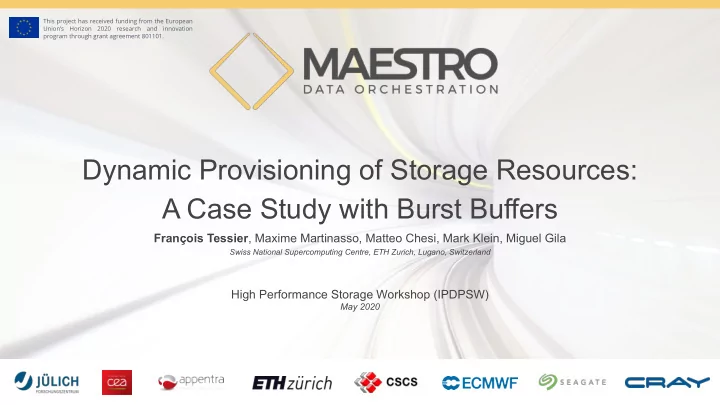

This project has received funding from the European Union’s Horizon 2020 research and innovation program through grant agreement 801101. Dynamic Provisioning of Storage Resources: A Case Study with Burst Buffers François Tessier , Maxime Martinasso, Matteo Chesi, Mark Klein, Miguel Gila Swiss National Supercomputing Centre, ETH Zurich, Lugano, Switzerland High Performance Storage Workshop (IPDPSW) May 2020
Context Complex workflows or frameworks in various scientific domains have increasing I/O needs Institution Scientific domain Workflows Data size (real & projection) European Centre for Weather Forecast Ensemble forecasts, data 12PB/year Medium-Range Weather Forecasts assimilation,... (ECMWF) Paul Scherrer Institute (PSI) Synchrotron imaging X-ray spectroscopy, high 10-20PB/year resolution microscopy,... Cherenkov Telescope Array (CTA) Astrophysics Gamma Rays & Cosmic 25PB/year Sources,... ● Workloads with specific needs of data movement ○ Big data analysis, machine learning, checkpointing, in-situ, co-located processes, … ○ Multiple data access pattern (model, layout, data size, frequency) 2
Context Scientific domains require more and more often varied data managers (object-based storage, database, …) ● Data management inside a workflow usually relies on a global shared parallel file system ○ Unique data access semantic (POSIX) ○ Performance variability ● Workflow specific data managers are installed on a use case basis Limited support and Specialized and OR reduced capacity expensive 3
Dynamic Resource Provisioning ● Provisioning of storage system at job level: ○ Storage available during the job lifetime ○ Storage resources dedicated to a job (isolation) ● Dynamically supply a data management system on top of those resources ○ Several types supported: file system (current), object-based storage, database ○ Containerized data management services ○ Deployment integrated at a job scheduler level 4
Proof of concept: BeeGFS on Cray DataWarp ● Repurposing Cray DataWarp nodes ● Get an allocation of intermediate storage nodes along with compute nodes ● Deploy a well-sized BeeGFS across disks on DataWarp nodes ● Configure the compute nodes to act as clients of the BeeGFS instance 5
Performance Evaluation ● Dom, Cray XC50 system with DataWarp at CSCS ○ Test and development system of Piz Daint (27PFlops) ○ 8 nodes with two 18-cores Intel Broadwell CPU and 64GB of DRAM ○ 4 DataWarp nodes each with three 5.9TB PCIe SSD ● On demand-BeeGFS (2 DW nodes) VS Lustre file system (Sonexion 1600, 2 OSTs) ● IOR benchmark: independent I/O, 10 runs Single shared file File per process 6
Performance Evaluation ● Small-scale study of… scalability ● IOR from 8 compute nodes (36 ppn) ○ 256MB written/read per process ● Dynamically provisioned BeeGFS ○ From 1 to 4 nodes ○ Ratio metadata:storage server per node kept to 1:2 ● Reasonable scalability overall ○ Except SSF - write 7
Conclusion ● Proof of concept of a mechanism to dynamically provision data managers on top of intermediate storage resources ○ Focused on containerized BeeGFS + DataWarp ● Promising performance and scalability with IOR and the I/O kernel of a real application ● Portability on different types of hardware and systems ● Next steps ○ Integration within the job scheduler (prolog/epilog scripts) ○ Configurable system for deployment: architecture’s description, data manager-specific settings, … ○ Extends to other data managers packaged in a unique container Acknowledgment ● This work is part of the MAESTRO EU Project ● 3-year European project, started in September 2018 ● Middleware library that automates data movement across diverse memory systems ● https://www.maestro-data.eu/ 8
Conclusion Contacts François Tessier , Maxime Martinasso, Matteo Chesi, Mark Klein, Miguel Gila Swiss National Supercomputing Centre, ETH Zurich, Lugano, Switzerland {firstname}.{lastname}@cscs.ch 9
10
Recommend
More recommend